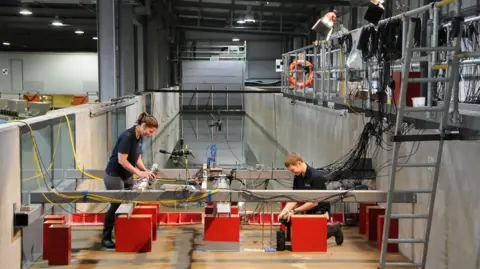How lab-generated tsunamis are helping worldwide
 HR Wallingford
HR WallingfordTwenty years on from the Boxing Day Indian Ocean tsunami, there are still things we do not know about the phenomenon.
More than 230,000 people died after a 9.1 magnitude earthquake under the sea in northern Indonesia caused waves that travelled up to 500mph (805km/h).
But a tsunami is not just a big wave - there is a "huge difference" in how they are generated, according to coastal engineer Dr Ian Chandler.
He is part of a team in Wallingford, Oxfordshire, that is recreating tsunamis in a laboratory in a bid to learn more about them and reduce how deadly they are.
 Getty Images
Getty Images"With the storm waves, we generate them using a piston paddle... and you're mechanically pushing the water backwards and forwards to create the waves," said Dr Chandler.
But ordinary storm waves are "relatively short", taking about16-18 seconds to pass in their entirety.
"[With] tsunamis, you're looking at maybe 20 minutes to half an hour for that same trough and crest of a wave to come past you," he said.
It is one of the reasons they are so destructive - and also means scientists have to take a different approach to generating them.
"The way we need to move the water is completely different," said Dr Chandler.
"We ended up using a pneumatic system, essentially sucking the water up and then releasing."
 HR Wallingford
HR WallingfordDr Chandler said the 2004 Indian Ocean tsunami was a turning point in the study of them.
"It was the biggest tsunami that had happened in recent times... and it was also the first one where we had mobile phone footage, where we had that sort of imagery of the events unfolding," he said.
"It was a real wake-up call to the world but also to the scientific and engineering community."
 HR Wallingford
HR WallingfordSince then, a team of scientists at HR Wallingford, in partnership with University College London and London South Bank University, have been studying them to see how different factors such as building placement, sea walls, coastal vegetation and the angle of beaches affects the behaviour of the waves.
"We're representing sometimes kilometres of coastline in some of our beach models," said Dr Chandler.
The team is also one of the first to attempt to model the entire wave - including when it flows back to the sea.
"That's an area that we're really lacking in our understanding still, even 20 years on," he said.
Ultimately, the aim of the research is to reduce the devastation caused by tsunamis.
"It sometimes feels a bit strange to be studying tsunamis in the middle of Oxfordshire but that research is helping people all over the world," he said.
 HR Wallingford
HR WallingfordYou can follow BBC Oxfordshire on Facebook, X (Twitter), or Instagram.
